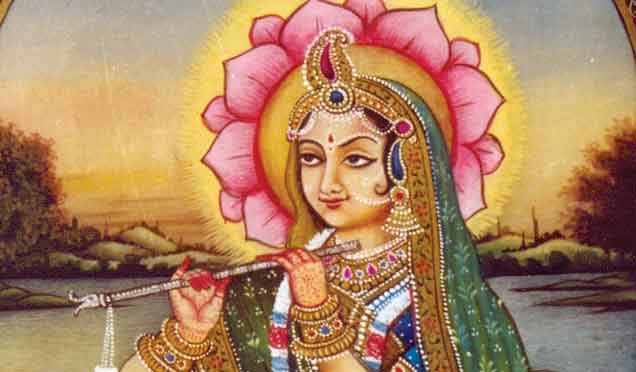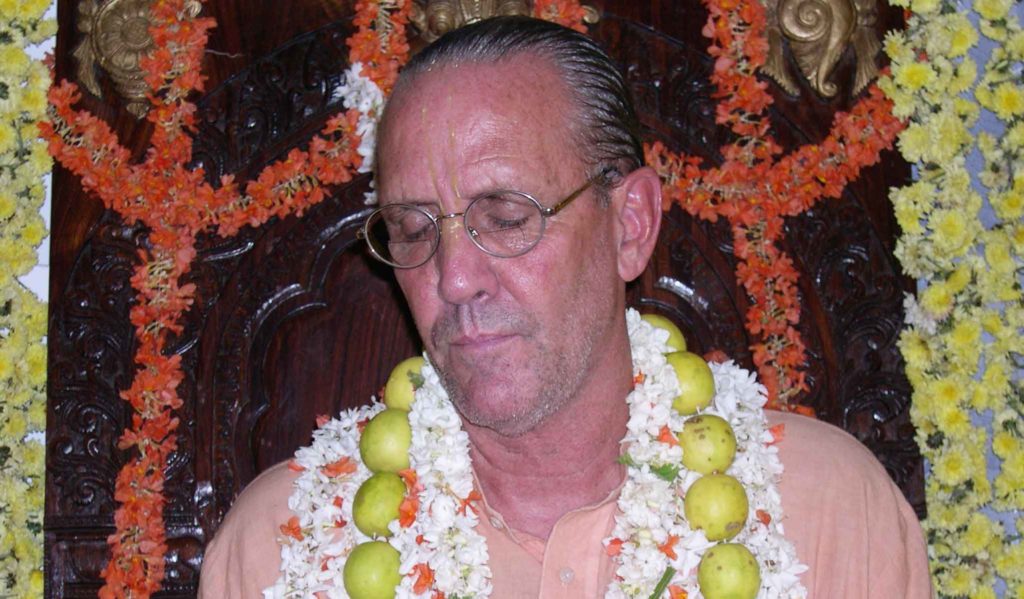Overview
‘The Definition of Faith’ written by Gaura Gopāla Dāsa gives a clear description of faith, or śraddhā, as delineated by the Gauḍīya Vaiṣṇava śastra. Is faith an abstract construct of the mind or is it the halo of Śrīmatī Rādhārāṇī?
How can one define faith? Is it a feeling? A function of the brain? Or is it just unfounded belief? The English word ‘Faith’ is associated with many things. The word is used to define a trust or belief in someone or something but more commonly it is used in association with religion and God.
The definition of the word faith in the unabridged Oxford Dictionary is:
1 complete trust or confidence.
2 strong belief in a religion.
3 a system of religious belief.
The English word faith originates from the Latin word fideis which comes from the ancient Greek word pistis. In Greek mythology pistis was the spirit of trust, honesty and good faith. She was one of the benevolent spirits that escaped from Pandora’s box who then fled back to heaven and abandoned mankind. Her Roman counterpart was Fides the goddess of trust. Fides actually has nothing to do with the concept of faith as we know it today. Fides meant reliability or a sense of trust — it was a virtue that was expected in all good people. It was only later during the early Christian period that fides came to denote faith in the Christian sense of the word.
Presently faith suggests a strong belief in something with no supporting evidence or empirical proof. When there is something that cannot be seen with the naked eye or understood by our senses then it is generally discounted as something nonexistent or to be taken on faith. The reality of this world is that so much of it is based on faith. There are many things with which the individual has no direct experience of, yet he considers these to be true on the basis of faith. This idea can be illustrated by the knowledge that a child gains from the parents. The child will typically hold the parents as a credible source of information even without sufficient research to prove their credibility. The child’s belief in the parents teaching is based on the faith that their teachings are credible. In order to be taught something a person has to have faith in a teacher. This can even be said of scientific knowledge. One must have faith that the researcher or scientist responsible for an empirical conclusion is competent, and trustworthy. Thus in every instance of life faith is required in order to attain knowledge of any kind.
Faith & Rational Thinking
As people place their faith in scientific conclusions and evolutionary theories, they fail to take many things into account. If one observes the method in which scientific research is conducted, generally it begins with various theories and presuppositions — almost everything is changeable or disposable. Scientific theories have been revised, rethought and proven wrong throughout history. To place one’s faith in this guessing game can be a disappointing venture.
We as humans are limited by the senses that our body comes equipped with. People relate so much with their bodies and senses that it becomes almost impossible to think outside of the small realm of experience that we have access to. The senses are only able to perceive things that are situated in the realm of gross matter. This is most mundane approach to acquiring knowledge that leaves out all subtle and invisible elements. Even in the realm of gross matter so much of it cannot be perceived with our limited senses. We cannot perceive things that are too small (like the atom), things that are hidden (like the stars in the daytime) or even the latent potential of a certain element (such as the potential of milk to become yogurt).
According to the Vedic way of thinking there are four defects present in all people.
1) Bhrama — subject to illusion. This means that one may perceive one thing to be another. A classic example of this is someone who sees a piece of rope lying on the ground and mistakes it for a snake. This illusion also extends to one’s own self. We are in illusion about our identity. We have forgotten our spiritual position and have begun to identify ourselves with this temporary body.
2) Pramāda — the tendency to make mistakes. Everyone makes mistakes arising from carelessness or inattention. When we are not focused on a particular task then we end up making mistakes.
3) Vipralipsā — the desire to deceive. This desire arises when one finds it advantageous to exploit someone or withhold the truth from another.
4) Karaṇapāṭava — imperfect senses. Every single one of our senses is limited. Each sense organ is limited to one function (our eyes can only see our ears can only hear etc.). Even within the limitation of the particular function they are meant to perform they are defective. The capacity of our senses is greatly impaired by different circumstances (insufficient light or the distance of the object from the viewer). Even under ideal circumstances these senses can provide imperfect information.
In Sanskrit the word for faith is śraddhā. Śraddhā comes from two root words śrat + dadhāti, meaning that which leads to truth and reality. There are two types of faith to be had by the individual. One is transcendental faith (paramārthika–śraddhā) and the other is mundane faith (laukika-śraddhā). If one places their faith in mundane knowledge, then it will be tainted with the defects of human nature (as stated above). Transcendental faith is standing on more sturdy ground because the conclusions that are drawn from it are coming from a higher source free from material defects. Some may argue that it is not a rational way of thinking to have belief in a Creator or to have belief in the theory of intelligent design. Yet it would seem to be a more rational conclusion to attribute the multi-dimensional complexity of the universe to an intelligence beyond our own. Is it rational to put your faith in so many inconclusive theories that would have you believe that the universe was generated from random particles colliding with each other and evolving over the millennia? Most of the evolutionary theories are outdated, inconclusive or have been proven wrong. For so many years people take these theories as facts proven by in depth scientific study, then when proven as incorrect they are replaced with new ideas and theories — is that where we want to place our faith? A sincere person seeking the truth should not be satisfied with these ideas and should search in a wider spectrum with an open mind.
The Learning Process
In order to compound one’s faith one must have a foundation of knowledge otherwise there is a risk of blind faith. The Vedic scriptures tell of three ways in which a person attains knowledge. The first and most common is called pratyakṣa or direct perception. Much of our basic learning comes from direct experience of the world around us. There are two types of pratyakṣa, external (knowledge acquired through the senses) and internal (to perceive emotions within ourselves such as pain, pleasure, love and hate). Everyone accepts pratyakṣa as a valid medium with which to obtain knowledge but it is not always reliable for several reasons. It is limited to the present (you cannot have direct experience of the past or the future), it is limited to material things (spiritual elements cannot be perceived with material perception) and it is also limited by imperfect senses.
The second is called Anumāna or inference. This means to reach a conclusion based on evidence, reasoning and prior experience. There is an example in the Vedas of ‘fire on the mountain’. One sees that there is smoke rising from the mountainside and thinks, “There is fire on the mountain.”
There are five steps taken in order to reach this conclusion.
1) Pratijña (Proposition): There is fire on the mountain.
2) Hetu (Reason): Because it is smoky.
3) Udaharana (General principle and example): Where there is smoke there is fire
4) Upanaya (Application): There is smoke over the mountain
5) Nigamana (Conclusion): Therefore there is a fire on the mountain.
Through the evidence at hand, reasoning and prior experience a person will reach the conclusion that there is a fire on the mountain despite not directly seeing fire.
This process is also not free of faults, because it still involves the imperfect senses. One could mistake a fog bank or cloud to be smoke. If the reason is wrong, then the conclusion is also wrong.
Then the third is called Śabda. Śabda means to hear from a person who is a trustworthy authority on a particular subject matter. Śabda can refer to any authority on any subject (i.e. a history teacher is an authority on the subject of history). However, a deeper meaning of śabda refers to knowledge of reality that is coming from a reliable source free from the four defects of human nature. This is known as apauruṣeya-śabda, meaning it has no human origin and is untainted by material defects. Apauruṣeya also means that which is eternally existing without beginning. The Vedic literature is apauruṣeya as they are handed down through an unbroken disciplic succession from their eternal and untainted source, Kṛṣṇa. This is the strong link to pure knowledge.
Conclusion
Paramārthika-śraddhā (transcendental faith) should be our only concern. Because through this faith we can advance our understanding and spiritual capacity. However śraddhā is only the first step in spiritual advancement.
Śrī Rūpa Gosvāmī, one of the foremost teachers in the disciplic succession of the Gauḍīya Vaiṣṇavas describes the stages of advancement required to attain self-realization in the following verse:
adau śraddhā tathā sādhu-saṅga bhajana-kriyā
tato ‘nartha-nivṛttiḥ syāt tato niṣṭhā ruciś tataḥ
athāsaktis tato bhāvas tataḥ premābhyudañcati
sādhakānām ayaṁ premṇaḥ prādurbhāve bhavet kramaḥ
“In the beginning one must have faith and the desire for self-realization. This will bring one to the stage of trying to associate with persons who are spiritually elevated. In the next stage one becomes initiated by an elevated spiritual master, and under his instruction the neophyte devotee begins the process of devotional service. By execution of devotional service under the guidance of the spiritual master, one becomes free from all material attachment, attains steadiness in self-realization, and acquires a taste for hearing about the Absolute Personality of Godhead, Śrī Kṛṣṇa. This taste leads one further forward to attachment for Kṛṣṇa consciousness, which is matured in bhāva, or the preliminary stage of transcendental love of God. Real love for God is called prema, the highest perfectional stage of life”. (Bhakti-rasāmṛta-sindhu 1.4.15-16)
Faith is the basis of all things and as we advance spiritually then our faith also develops and grows. In Vedic philosophy faith is not an abstract or impersonal concept, it is not a state of mind but an energy that stimulates the heart and confirms the spiritual path for the devotee. Faith in its purest form is the halo of Śrīmatī Rādhārāṇī by the light of which we may understand Kṛṣṇa.
“Śraddhā, faith, is the most subtle thing, and it is also the most tangible. It is not imaginary. We must realise that it is reality, it is concrete, and not merely an abstract sentiment of mere individual consciousness. Faith is universal as the most fundamental element that can connect us with the finest objective.” (Śrīla Bhakti Rakṣaka Śrīdhara Mahārāja)
Related Articles & Books
- Vaiṣṇava Nindā by Śrīla Bhaktivinoda Ṭhākura
- A Devotee is Merciful (Sajjana – Kṛpālu) by Śrīla Bhaktisiddhānta Sarasvatī Ṭhākura
- A Devotee Does Not Engage in Violence (Sajjana – Akṛta-droha) by Śrīla Bhaktisiddhānta Sarasvatī Ṭhākura
- A Devotee is the Epitome of Truth (Sajjana – Satya-sāra) by Śrīla Bhaktisiddhānta Sarasvatī Thākura
- Śiva-tattva & the Position of Lord Śiva by Śrīla B.R. Śrīdhara Mahārāja
- Oh Bābā! Bolacche-re! by Śrīla B.R. Śrīdhara Mahārāja
- Problems and Solutions by Śrīla B.R. Śrīdhara Mahārāja
- The Highest Attainment and Present Adjustment by Śrīla B.R. Śrīdhara Mahārāja
- Āgun Jvālbe (Light the Fire!) by Śrīla B.R. Śrīdhara Mahārāja
- Dharma and the Modern World by Śrīla A.C. Bhaktivedānta Swami Prabhupāda
- Faith Confirms the Absolute by Śrīla B.G. Narasiṅgha Mahārāja
- Go Deeper! by Śrīla B.G. Narasiṅgha Mahārāja
- To Be a Servant by Śrīla B.G. Narasiṅgha Mahārāja
- Harmony – Real and Apparent by Swami B.V. Giri
- The Definition of Faith by Gaura Gopāla Dāsa
- Ātma Samīkṣā – The Value of Introspection by Kalki Dāsa
- Frogs in the Well of Prejudice by Kalki Dāsa
Further Reading
- Śraddhā (Faith) – Quotes by Bhaktivinoda Thakura
- Śraddhā and Śaraṇāgati by Śrīla Bhaktivinoda Ṭhākura
- The Association of Sādhus by Śrīla Bhaktivinoda Ṭhākura
- Epilogue to Śrī Kṛṣṇa Karṇāmṛta by Śrīla Bhaktivinoda Ṭhākura
- Prīti (Love) by Śrīla Bhaktivinoda Ṭhākura
- A Dispute Concerning Mahāprasāda by Śrīla Bhaktivinoda Ṭhākura
- Śraddhā by Śrīla Bhaktivinoda Ṭhākura
- Materialistic Association by Śrīla Bhaktivinoda Ṭhākura
- Dispelling Doubts by Śrīla Bhaktivinoda Ṭhākura
- The Enemy by Śrīla Bhaktivinoda Ṭhākura
- A Critique of the book ‘Vanamālā’ by Śrīla Bhaktivinoda Ṭhākura
- Kali by Śrīla Bhaktivinoda Ṭhākura
- Offences Against Bhakti by Śrīla Bhaktivinoda Ṭhākura
- Kārttika-vrata by Śrīla Bhaktivinoda Ṭhākura
- Violence and Mercy by Śrīla Bhaktivinoda Ṭhākura
- Abandoning Bad Association by Śrīla Bhaktivinoda Ṭhākura
- Sad-guṇa and Bhakti by Śrīla Bhaktivinoda Ṭhākura
- The Process of Initiation by Śrīla Bhaktivinoda Ṭhākura
- Dainya (Humility) by Śrīla Bhaktivinoda Ṭhākura
- Vaiṣṇava Nindā (Offences to Devotees) by Śrīla Bhaktivinoda Ṭhākura
Prema Dhāma Deva Stotram with the Narasiṅgha Sevaka Commentary – Verses 61-65
In verses 61 to 65 of 'Prema Dhāma Deva Stotram', Śrīla Śrīdhara Mahārāja narrates the pastime of Śrī Caitanya at Caṭaka Parvata In Purī and explains how the scriptures produced by Brahmā and Śiva are ultimately searching for the personality of Mahāprabhu who is merciful too all jīvas, no matter what their social position.
Prabhupāda Śrīla Sarasvatī Ṭhākura’s Visit to Ayodhyā
With the forthcoming observance of Śrī Rāma Navamī, we present 'Prabhupāda Śrīla Sarasvatī Ṭhākura’s Visit to Ayodhyā' written by Śrīla Bhaktisiddhānta Sarasvatī Ṭhākura Prabhupāda from The Gaudīyā magazine, Vol 3. Issue 21/ In December 1924, after visiting Benares and Prāyāga, Sarasvatī Ṭhākura visited the birth-site of Śrī Rāmācandra in Ayodhyā.
Śaraṇāgati – The Only Path to Auspiciousness
In this article, 'Śaraṇāgati - The Only Path to Auspiciousness', Dhīra Lalitā Dāsī analyses the process of śaraṇāgati (surrender) beginning with śraddhā (faith). She also discusses the role of śāstra and the Vaiṣṇava in connection with surrender.
Ātma Samīkṣā – The Value of Introspection
In this article, "Ātma Samīkṣā – The Value of Introspection" Kalki Dāsa highlights the importance of introspection in the life of a devotee and especially in relation to the worldly environment that surrounds us. He also explains how transcendental sound influences our capacity to introspect.
Prema Dhāma Deva Stotram with the Narasiṅgha Sevaka Commentary – Verses 61-65
In verses 61 to 65 of 'Prema Dhāma Deva Stotram', Śrīla Śrīdhara Mahārāja narrates the pastime of Śrī Caitanya at Caṭaka Parvata In Purī and explains how the scriptures produced by Brahmā and Śiva are ultimately searching for the personality of Mahāprabhu who is merciful too all jīvas, no matter what their social position.
Prabhupāda Śrīla Sarasvatī Ṭhākura’s Visit to Ayodhyā
With the forthcoming observance of Śrī Rāma Navamī, we present 'Prabhupāda Śrīla Sarasvatī Ṭhākura’s Visit to Ayodhyā' written by Śrīla Bhaktisiddhānta Sarasvatī Ṭhākura Prabhupāda from The Gaudīyā magazine, Vol 3. Issue 21/ In December 1924, after visiting Benares and Prāyāga, Sarasvatī Ṭhākura visited the birth-site of Śrī Rāmācandra in Ayodhyā.
Śaraṇāgati – The Only Path to Auspiciousness
In this article, 'Śaraṇāgati - The Only Path to Auspiciousness', Dhīra Lalitā Dāsī analyses the process of śaraṇāgati (surrender) beginning with śraddhā (faith). She also discusses the role of śāstra and the Vaiṣṇava in connection with surrender.
Ātma Samīkṣā – The Value of Introspection
In this article, "Ātma Samīkṣā – The Value of Introspection" Kalki Dāsa highlights the importance of introspection in the life of a devotee and especially in relation to the worldly environment that surrounds us. He also explains how transcendental sound influences our capacity to introspect.








